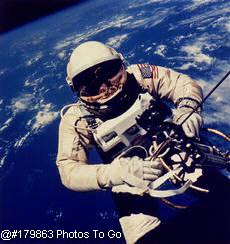|
-named after the famous twins Castor and Pollux
The goals of the Gemini Program
1.stay in space for fourteen days
2.rendezvous and dock
3.perfect methods of reentering the atmosphere
-the rocket that launched the Gemini capsules was called the Titan Two
-a highlight of this project was when Ed White became the first American man to perform an EVA
-total cost of this mission was $1.3 billion
-space race became a race to the moon
-NASA increased workforce from 16000 in 1961 to 33000 in 1965
-capsules were bell shaped and held two astronauts
-they were 19 feet long and weighed 8400 lbs
-hatch designed to open and close for space walks
-there was an orbital maneuvering system, it would move the capsule in any direction and to make it accelerate and decelerate

-Gemini I and II were un-piloted
-Gemini I was in space for 64 hours
-Gemini II was in a sub orbital flight
-two astronauts flew twice during the program
Gemini III
astronauts:Gus Grissom, John Young
launched March 23, 1965
-was in space for three orbits
-up in space for five hours
-could control oval orbits into more circular orbits
Gemini IV
astronauts:James McDivitt, Ed White
launched June 3,1965
-planned EVA
-broadcast to twelve nations of the world
-first American space walk (Ed White)
-out in space for 21 minutes
Gemini V
astronauts:Gordan Cooper, Charles Conrad Jr.
launched August 21, 1965
-up in space for eight days
-128 orbits
-was able to rendezvous with an imaginary target
Gemini VI
astronauts:Wally Schirra, Thomas Stafford
scheduled to launch October 25, 1965
-canceled because the Agena target vehicle exploded during launch
Gemini VII
astronauts:Frank Borman, James Lowell
launched December 4, 1965
-flight lasted 14 days
-studied physical effects of long flights on astronauts
-Gemini VI was launched eleven days later and then beagn to rendezvous with Gemini VII
-they were close enough to wave at each other
-December 16 Gemini VI returned to Earth after 17 orbits
-Gemini VII was in space for three more days
-spent 330 hours in space with 220 orbits
-proved humans could endure lunar missions (up yo two weeks)
Gemini VIII
astronauts:Neil Armstrong, David Scott
launched March 16, 1966
-achieved docking with an Agena target vehicle
-the spacecraft began spinning rapidly but Armstrong was able to slow the spinning by using the thrusters to control the
craft but it began again
-figured the problem was in the target vehicle and they were instructed to separate
-began to spin faster, one revolution per second
-astronauts barely conscious, had trouble seeing
-Armstrong broke the mission rule
-turned off thruster system and turned on reentry control system
-hand controllers turned on and the astronauts controlled their own spacecraft
-forced emergency landing in the Pacific Ocean
-found out a maneuvering thruster was stuck in the open position causing it to spin
Gemini IX
astronauts:Thomas Stafford, Eugene Cernan
launched June 3,1966
-original team chosen was Elliot See and Charles Bassett but they died in a plane crash
-planned three day flight
-its docking did not happen, the protective cover one the Agena remained somewhat attached
-when an EVA was started suit fogged up and could not be cleared up with the suit's air conditioner
-the space walk was terminated
-did not get to try out new jet pack
Gemini X
astronauts:John Young, Michael Collins
launched July 18, 1966
-docking successful
-5 hours and 21 minutes after launch Collins took pictures of the stars in ultraviolet lights
-three day mission
-Collins had a 39 minute EVA
-hugely successful mission
Gemini XI
astronauts:Charles Conrad Jr., Richard Gordan Jr.
launched September 12,1966
-saw more than 17 million square miles of Earth
-second day Gordan performed an EVA
-face fogged, EVA terminated (similar to Gemini IX)
-created artificial gravity
-tethered two spacecrafts together and let them slowly rotate around each other
Gemini XII
astronauts:James Lowell Jr., Edwin Aldrin
launched November 11,1966
-final mission
-four hours after launch they rendezvoued with their Agena target vehicle-extended EVA by Aldrin, lasted two hours and
20 minutes
-completed 20 simple tasks (related to future spacecraft repair)
-new record for EVA
|

